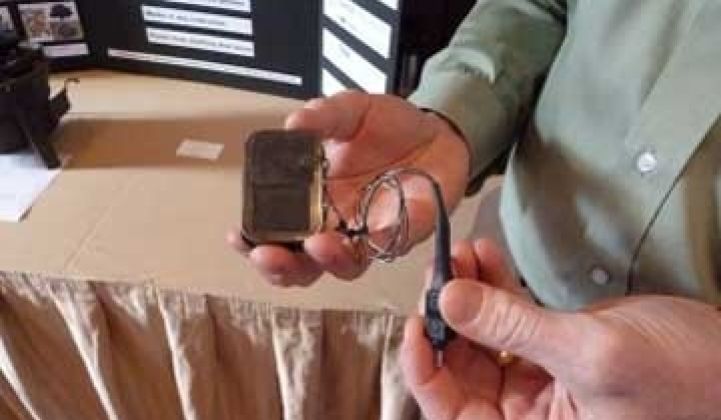Sausalito, Calif.--Toss that thing in the picture into a fire, let it sit for a bit, and soon you will be able to charge your cell phone.
Point Source Power, a startup spun out of research conducted at Lawrence Berkeley National Labs, has devised an economical fuel cell for emerging markets. The one in the picture is built around a container that once held breath mints and will generate two to three watts of power.
Potentially, consumers soon will be able to insert biomass into the case, close it up and put it into a cooking pit or fire. As it heats, the biomass will generate gases, which in turn will be converted into electrical power via a thin ceramic membrane inside the contraption.
"You can fill it with wood, charcoal, cow dung," said Craig Jacobson of Point Source (see cryptic website here).
The one in the picture will cost around $4. A bigger one out of an Altoids box might cost more, but could generate more power because it could hold more biomass. Conceivably, fuel cells that generate hundreds of kilowatts could be constructed from the same basic technology.
The company hopes to test prototypes out later this year in Kenya. Khosla Ventures has invested in the company. Point Source showed its prototype as part of a small conference held by the firm in Sausalito today, where Tony Blair spoke this morning.
Several companies -- Toshiba, MTI -- have tried to market micro fuel cells for years with almost no luck whatsoever, but Point Source's differs in three key respects. One, the fuel is largely free. Fuel cells from Toshiba, MTI and others run on methanol.
Two, the Point Source device is far more convenient. Even in countries where dung remains a common household fuel, it's easy to find. (You could even scoop up fuel with the hinged case.) Toshiba and others have always talked about selling methanol fuel cartridges in convenience stores and drug stores. Even rechargeable batteries seem more convenient than that.
Right now, many consumers have to pay 15 to 40 cents to charge their cell phones in emerging markets, and that's when power is available, said Jacobson. Electricity theft and blackouts remain chronic, daily headaches in India. Consumers would, ideally, be able to pay back the cost of their micro fuel cell in a month.
Three, Point Source has created a solid oxide fuel cell: a rigid ceramic membrane containing an oxide like zirconium oxide does the heavy lifting. The energy server unfurled earlier this year from Bloom Energy is also a solid oxide fuel cell. (Bloom's secret ingredient is zirconium oxide; Point Source did not divulge theirs.) Toshiba makes a direct methanol fuel cell, which has an entirely different membrane. (Hydrogen fuel cells, meanwhile, rely on a proton exchange membrane.) Solid oxide fuel cells are finicky: companies have struggled with them for years and most remain stuck in labs. Nonetheless, they can operate fairly efficiently.
Point Source keeps the price low by keeping the amount of active material inside the fuel cell to a minimum.
"You have to get rid of the ceramic," Jacobson said.



